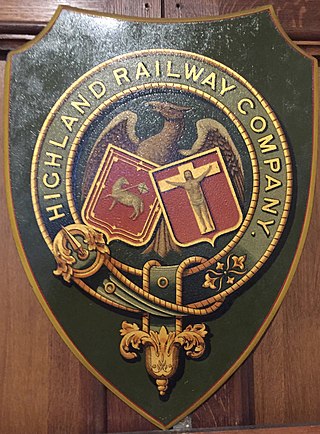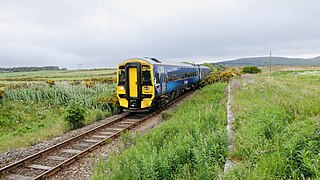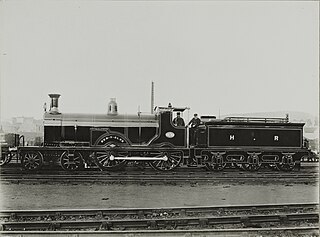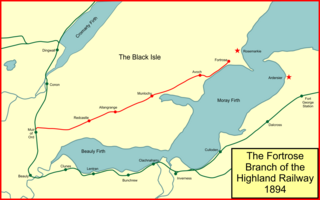
The Highland Railway (HR) was one of the smaller British railways before the Railways Act 1921, operating north of Perth railway station in Scotland and serving the farthest north of Britain. Based in Inverness, the company was formed by merger in 1865, absorbing over 249 miles (401 km) of line. It continued to expand, reaching Wick and Thurso in the north and Kyle of Lochalsh in the west, eventually serving the counties of Caithness, Sutherland, Ross & Cromarty, Inverness, Perth, Nairn, Moray and Banff. Southward it connected with the Caledonian Railway at Stanley Junction, north of Perth, and eastward with the Great North of Scotland Railway at Boat of Garten, Elgin, Keith and Portessie.

The Far North Line is a rural railway line entirely within the Highland area of Scotland, extending from Inverness to Thurso and Wick. As the name suggests, it is the northernmost railway in the United Kingdom. The line is entirely single-track, with only passing loops at some intermediate stations allowing trains to pass each other. Like other railway lines in the Highlands and northern Lowlands, it is not electrified and all trains are diesel-powered.

The Highland Railway's Clan Goods class was a class of steam locomotive. They were designed by Christopher Cumming. The first four were built by Hawthorn Leslie and Company on Tyneside, and the maker's plates bore the date 1917, but because of wartime delays were not delivered until 1918. Four more were built in 1919, also by Hawthorn Leslie.

The Highland Railway Ben Class were small 4-4-0 passenger steam locomotives. There were actually two separate 'Ben' classes, usually referred to as the 'Small Bens' and the 'Large Bens'.
The Highland Railway E Class was a class of 4-4-0 steam locomotive designed by David Jones for passenger service. They were also known as the 'Clyde Bogies' as they were built by the Clyde Locomotive Company in Glasgow, Scotland. They were the first locomotives built by that company.

The Highland Railway Jones Goods class was a class of steam locomotive, and was notable as the first class with a 4-6-0 wheel arrangement in the British Isles. Fifteen were built, and one has survived to preservation. Originally known as the Big Goods class, they became class I under Peter Drummond's 1901 classification scheme.
The Highland Railway W Class were four small 0-4-4T locomotives built by the Highland Railway in 1905–1906 to the design of locomotive superintendent Peter Drummond. They were the last engines that were built at the company's Lochgorm works in Inverness, and were used on branch line services.

Georgemas Junction railway station is a railway station located in the Highland council area in the far north of Scotland. It serves several rural hamlets in the historic county of Caithness, including Georgemas, Roadside and Banniskirk. It is also the nearest station to the village of Halkirk, which lies approximately 1.6 miles (2.6 km) west of the station.

Dornoch railway station formerly served the town of Dornoch in Sutherland, Scotland.

The Wick and Lybster Light Railway was a light railway opened in 1903, with the intention of opening up the fishing port of Lybster, in Caithness, Scotland, to the railway network at Wick. Its construction was heavily supported financially by local government and the Treasury. It was worked by the Highland Railway.
The Sutherland Railway was a railway company authorised in 1865 to build a line from Bonar Bridge station to Brora, a distance of nearly 33 miles, in the north of Scotland. This was to be continuation of a route from Inverness to Bonar Bridge that had been built by the Inverness and Ross-shire Railway; ultimately the line was extended to Thurso.

The Fortrose Branch, also known as the Black Isle Railway, was a railway branch line serving Fortrose in the Black Isle, in the north of Scotland. It was built by the Highland Railway as a tactical measure to exclude a rival railway company and to move the locals from Fortrose onwards to other destinations.
The Buckie and Portessie Branch was a railway branch line in Scotland, built by the Highland Railway to serve an important fishing harbour at Buckie, in Banffshire. It connected with the rival Great North of Scotland Railway at Portessie.
The Clyde Locomotive Company was a firm of locomotive manufacturers in Springburn, Glasgow, Scotland.

The Mound railway station was a former railway station on the Far North Line near the head of Loch Fleet in Scotland. For more than half of its life it was the junction for Dornoch.
The Far North Line was built in several stages through sparsely populated and undulating terrain within the Highland area of Scotland. Extending to 161 miles (259 km), it runs north from Inverness to Wick and Thurso in Caithness, and currently carries a regular passenger train service.

Embo railway station formerly served the town of Embo in Sutherland, Scotland.

Skelbo railway station was a halt on the Dornoch Light Railway serving the village of Skelbo in Sutherland, Scotland.

The Highland Railway 'Castle Class' was a class of 4-6-0 locomotives designed in 1900 by Peter Drummond, chief mechanical engineer of the Highland Railway at the time. 19 locomotives were built by Dübs and North British Locomotive Co. until 1917, and the last were withdrawn from service in 1947.

















